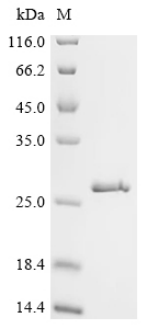Recombinant Human Serum amyloid P-component (APCS) is expressed in E. coli and covers the full length of the mature protein from amino acids 20 to 223. The protein carries an N-terminal 6xHis-tag, which makes purification and detection more straightforward. SDS-PAGE analysis confirms a purity level greater than 85%. This product is strictly for research use only—it's not suitable for diagnostic or therapeutic applications.
Serum amyloid P-component (APCS) is a pentameric protein from the pentraxin family. It binds to several ligands in a calcium-dependent manner and appears to play a role in immune system function. APCS seems to be involved in both amyloid plaque formation and clearance, making it particularly relevant for amyloidosis research and related conditions. Its biological activity and interactions have made it an important focus in studies examining protein aggregation and immune responses.
Potential Applications
Note: The applications listed below are based on what we know about this protein's biological functions, published research, and experience from experts in the field. However, we haven't fully tested all of these applications ourselves yet. We'd recommend running some preliminary tests first to make sure they work for your specific research goals.
Based on the provided information, the recombinant Human Serum Amyloid P-component (APCS) is expressed in E. coli, a prokaryotic system that may not support proper folding of this eukaryotic pentraxin protein. APCS requires precise folding to form its characteristic pentameric structure and calcium-dependent ligand binding capabilities. While the protein contains the full-length mature sequence (20-223aa), E. coli lacks the chaperone systems and post-translational modifications needed for correct APCS oligomerization. The N-terminal 6xHis tag may further interfere with native folding. Since activity is unverified, the protein cannot be assumed to be correctly folded or bioactive. Experimental validation is essential to confirm both proper oligomerization and functional activity.
1. Antibody Development and Validation Studies
This application is appropriate. The recombinant APCS can serve as an effective immunogen for antibody generation, as antibodies may recognize linear epitopes even if the protein is misfolded. The His-tag facilitates purification and screening. However, if APCS is misfolded or fails to form proper pentamers, antibodies may not recognize conformational epitopes of native, circulating APCS. Validation against human serum-derived APCS is recommended to ensure physiological relevance.
2. Protein-Protein Interaction Studies
This application is high-risk without folding validation. APCS functions through specific calcium-dependent interactions with various ligands (e.g., amyloid fibrils, DNA). If misfolded, pull-down assays may yield non-physiological interactions. The His-tag enables technical feasibility, but results require confirmation with native APCS. This application should only be pursued after confirming proper pentameric structure and calcium-binding capability.
3. Biochemical Characterization and Biophysical Analysis
This application is highly appropriate and should be prioritized. Techniques like size exclusion chromatography (to assess pentamer formation), circular dichroism (secondary structure), and dynamic light scattering (oligomeric state) can directly evaluate folding quality. These studies are valuable even if the protein is inactive, as they characterize the recombinant product. This should be the first application implemented.
4. ELISA Development and Quantitative Assays
This application is feasible but requires caution. If APCS is properly folded, it can serve as a standard for quantitative assays. However, if misfolded, calibration curves may be inaccurate, and antibodies may not detect native APCS correctly. It should be noted that assay validation against native APCS from human serum is essential for reliable quantification.
Final Recommendation & Action Plan
Given the uncertainty in folding and bioactivity, the recommended approach is to first perform comprehensive biophysical characterization (Application #3) to assess the protein's oligomeric state (particularly pentamer formation), secondary structure, and calcium-binding capability. If the protein shows proper pentameric structure, proceed with functional validation (e.g., amyloid binding assays). For antibody development (Application #1), the protein can be used immediately, but resulting antibodies should be validated against native APCS. Protein interaction studies (Application #2) should be deferred until folding is confirmed. ELISA development (Application #4) can proceed cautiously with inclusion of native APCS controls. The E. coli expression system is suboptimal for this complex pentraxin protein, so validation is particularly important for biologically relevant applications.






